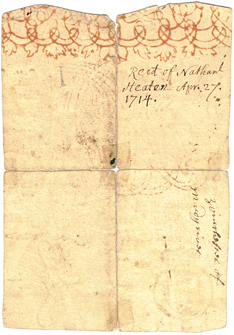Massachusetts Currency
May 31, 1710
An emission of £25,000 in indented bills of credit authorized on June 29, 1710, which was then increased by an additional £15,000 on July 28, 1710. The notes carry the date of May 31, 1710. This is the fifth Massachusetts emission and is one of the emissions that later was designated as "Old Tenor" notes. The plates used in the production of this emission were originally engraved by John Coney for the third Massachusetts emission, of November 21, 1702; these plates were later recut for the fifth emission so the year read 1708 (the 2 was changed to an 8). Some denominated were altered in the fifth emission and a red monogram AR (Anna Regina, which is Latin for Queen Anne) was added to the face of the notes. In this fifth emission the plates were more extensively altered with an entirely new date added to the text as well as altering some of the denominations. The denominations on the three original Coley plates were changed as follows: the lowest plate contained engravings printed a sheet with 2s, 2s6d, 3s and 3s6d notes; the middle plate printed a sheet with 4s, 5s, 10s, 20s notes; while the great plate printed a sheet with 40s, 50s, £3 and £5 notes. The middle and great plates were later used for the sixth Massachusetts emission in 1711, in this later issue the text was unaltered but the date 1711 was engraved in the blank space above the word Com
As in the third and fourth emissions the fifth emission contained a red scrollwork design on the top portion of the back of the note at the indent area. However in this emission the scrollwork was not added to the four lowest denominations (2s-3s6d) to deter alterations. From surviving examples of early notes we know individuals would take a low denomination note then erase the denomination and replace it by hand with a higher number, indeed one of the few surviving notes from the second Massachusetts emission of February 3, 1691 is a 20s note even though the emission only included notes of 2s, 2s6d, £3 and £6. It was hoped by excluding the scrollwork on low denomination notes in the fifth emission, individuals would have a more difficult time passing altered lower denomination notes. Another problem developed in that there were numerous counterfeit 20s notes in circulation from the third emission of November 21, 1702. By an act of November 4, 1710 all 20s notes from the third emission were recalled and £15,000 in new 20s notes bearing the date of the May 31, 1710 emission were printed as replacements.
The issue was printed by John Allen in Boston on a rolling press constructed by John Brewer. In the lower left corner is the English shield of three lions with the French motto HONI SOIT QVI MAL Y PENSE (Evil to him who thinks evil) and the coronet of the Prince of Wales above. On each denomination the design of branches and leaves around the shield differs, with no design added to the shield on the 20s note. Denominations for the May 31, 1710 issue were: 2s, 2s6d, 3s, 3s6d, 4s, 5s, 10s, 20s, 40s, 50s, £3 and £5.
obv
 rev
rev 
20s Serial Number: 12[8]1 MA 05/31/10 - Old tenor
Signers: Samuel Sewall, Penn Townsend, John Clark.
Size: 105 x 155mm.
Comments: Red monogram AR behind the printed text. This example was split into four sections and has been repaired. Like most surviving early Massachusetts notes this item is considered to be a contemporary counterfeit. Newman illustrates another example of this denomination in his 4th edition listing it as a counterfeit but without an explanation. Based on the annotations on the back this example was in circulation by 1714. On the reverse is the annotation: "Received of Nathaniel Heaten April 27, 1714." Also, along the lower side margin in another hand is the annotation: "Z Vinthester of Mudy river." Muddy River was the original name for Brookline. Click here for a 2.3 meg image of the front and the back.
Provenance: Purchased through the Robert H. Gore, Jr. Numismatic Endowment from the R. M. Smythe and Co. Fourth Annual Strasburg Paper Money Show Public and Mail Bid Auction, no. 191, September 17-18th, 1999, lot 1010, where it was listed as previously in the collections of Charles Affleck and John L. Roper.